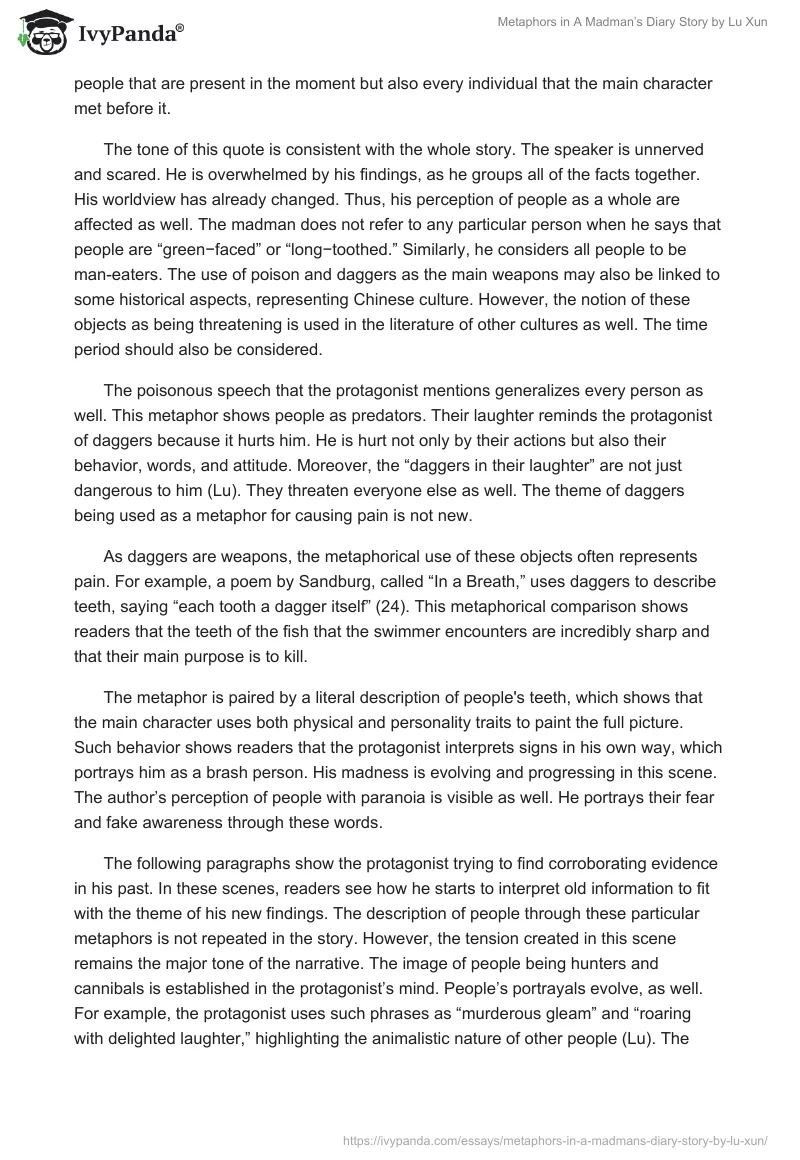Metaphors can serve various functions in literary works. Authors use them to portray feelings and actions through indirect channels. Some metaphors are currently widely recognized and understood. It is important to remember that many writers that included such metaphors in their works lived before these phrases became trite. For example, a short story by a Chinese author Lu Xun, called “A Madman’s Diary,” uses various metaphors that may be considered trite by modern critics.
However, the work does not lose its intensity because the used literary devices remain powerful and insightful. One of these metaphors can be seen in the third part of the story: “I see that woman’s ‘bite several mouthfuls out of you,’ the laughter of those green−faced, long−toothed people and the tenant’s story the other day are obviously secret signs. I realize all the poison in their speech, all the daggers in their laughter. Their teeth are white and glistening: they are all man−eaters” (Lu). Metaphors that compare one’s features and actions with various weapons such as poison or daggers are used similarly by various authors, but here they show how the author perceives a person’s mind captured by paranoia and madness.
This short story is presented in the form of a diary written by a man with paranoia. The plot follows his thought process as he starts suspecting people of being cannibals. As he writes down his thoughts and feelings, readers can see the progression of his madness. The discussed passage describes his relationship with his relatives, neighbors, and people that he encountered recently. At this moment, he comes to a realization that people that surround him eat people.
This passage shows how he sees other characters. His thoughts and suspicions are recent and not yet fully formed. However, they are established in his mind, which is visible from the earlier paragraphs. Before seeing this realization stated by the diary’s author, readers can follow his thought process. He bases his accusations on information that he gathered from reading books, listening to people’s stories, and analyzing phrases that he heard on the street. Thus, the metaphor is used not only to address people that are present in the moment but also every individual that the main character met before it.
The tone of this quote is consistent with the whole story. The speaker is unnerved and scared. He is overwhelmed by his findings, as he groups all of the facts together. His worldview has already changed. Thus, his perception of people as a whole are affected as well. The madman does not refer to any particular person when he says that people are “green−faced” or “long−toothed.” Similarly, he considers all people to be man-eaters. The use of poison and daggers as the main weapons may also be linked to some historical aspects, representing Chinese culture. However, the notion of these objects as being threatening is used in the literature of other cultures as well. The time period should also be considered.
The poisonous speech that the protagonist mentions generalizes every person as well. This metaphor shows people as predators. Their laughter reminds the protagonist of daggers because it hurts him. He is hurt not only by their actions but also their behavior, words, and attitude. Moreover, the “daggers in their laughter” are not just dangerous to him (Lu). They threaten everyone else as well. The theme of daggers being used as a metaphor for causing pain is not new.
As daggers are weapons, the metaphorical use of these objects often represents pain. For example, a poem by Sandburg, called “In a Breath,” uses daggers to describe teeth, saying “each tooth a dagger itself” (24). This metaphorical comparison shows readers that the teeth of the fish that the swimmer encounters are incredibly sharp and that their main purpose is to kill.
The metaphor is paired by a literal description of people’s teeth, which shows that the main character uses both physical and personality traits to paint the full picture. Such behavior shows readers that the protagonist interprets signs in his own way, which portrays him as a brash person. His madness is evolving and progressing in this scene. The author’s perception of people with paranoia is visible as well. He portrays their fear and fake awareness through these words.
The following paragraphs show the protagonist trying to find corroborating evidence in his past. In these scenes, readers see how he starts to interpret old information to fit with the theme of his new findings. The description of people through these particular metaphors is not repeated in the story. However, the tension created in this scene remains the major tone of the narrative. The image of people being hunters and cannibals is established in the protagonist’s mind. People’s portrayals evolve, as well. For example, the protagonist uses such phrases as “murderous gleam” and “roaring with delighted laughter,” highlighting the animalistic nature of other people (Lu). The narrator’s mood becomes more and more agitated as the story progresses, and he succumbs to his madness.
In the story “A Madman’s Diary,” Lu Xun uses various literary devices to portray a person suffering from paranoia. Through metaphors, the author compares the physical harmfulness of poison and daggers to the mental pain that affects the main character. All in all, these metaphors help the author to portray the character’s view of other people when his perception is skewed by madness.
Works Cited
Lu, Xun. “A Madman’s Diary.” Marxists Internet Archive, 2005. Web.
Sandburg, Carl. “In a Breath.” Chicago Poems: Unabridged, edited by Philip Smith, Dover, 2014, p. 24.


